Abstract
Integration of materials acts as a bridge between the electronic and biological worlds, which has revolutionized the development of bioelectronic devices. This review highlights the rapidly emerging field of switchable interface and its bioelectronics applications. This review article highlights the role and importance of two-dimensional (2D) materials, especially graphene, in the field of bioelectronics. Because of the excellent electrical, optical, and mechanical properties graphene have promising application in the field of bioelectronics. The easy integration, biocompatibility, mechanical flexibility, and conformity add impact in its use for the fabrication of bioelectronic devices. In addition, the switchable behavior of this material adds an impact on the study of natural biochemical processes. In general, the behavior of the interfacial materials can be tuned with modest changes in the bioelectronics interface systems. It is also believed that switchable behavior of materials responds to a major change at the nanoscale level by regulating the behavior of the stimuli-responsive interface architecture.
1. Introduction
Bioelectronics is an emerging and exciting field, which involves biological materials and biological architecture for information processing. According to the National Institute of Standard and Technology (NIST), bioelectronics involves the convergence of biology and electronics. Bioelectronics seeks to exploit biology in conjunction with electronics in a wider context encompassing, for example, information storage, bionics and biomaterials for information processing, biofuel cells, and electronic components and actuators. The main aspect of bioelectronics is the interface between biological materials and electronics [1,2,3]. Thus, the key concept of the bioelectronics is the transduction of the biological signals to electrical signals at the sensing interface.
Carbon-based materials have the capability to form a bridge between the biological and the electronic world and to fundamentally change the fabrication of bioelectronics devices such as bio-actuators, biofuel cells, and biosensors providing new window of opportunities to the future of bioelectronics. Carbon-based materials have the potential to crack past technical problems by communicating the biological entities to the electronic system at its interface [4,5] (Figure 1).
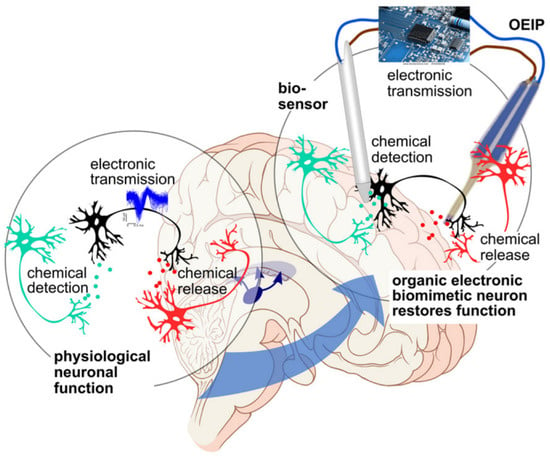
Figure 1.
Schematic depicting the merging of biotechnology, electronics and materials science [6].
For successful interfacing between electronic and biological system there must be a precise interface. Interface works as a shuttle between biological and electrical entities and enhances the electron transfer rate. To overcome these challenges, carbon-based materials emerges as a best-fitted model for the fabrication of bioelectronic interfaces; they play a crucial role in exploring the basics of their physical properties, chemical interaction, thermodynamics, and kinetics due to its remarkable surface area, morphological behavior, and electron transfer rate.
Whether at a commercial or laboratory level of development of bioelectronic devices, there is a need to comprehend the dynamic forces and respective component at molecular levels [7,8]. During the past decade, there have been remarkable achievements in material science of bioelectronic devices but there is still a need to explore the challenges of real-world scenario [9,10]. In the recent era, researchers are focusing more of their attention on the technical issues relating the practical application of bioelectronic interfaces.
In this review article, we look at graphene-based interface materials with their respective applications in the fields of biosensors and bioelectronics. In addition, we also highlight the future prospects of graphene-based bioelectronic interfaces by focusing on recent reports on electrochemical biosensing performance.
2. Fundamentals of 2D Materials and Graphene-Based Bioelectronic Interfaces
Before highlighting on the behavior of switchable bioelectronic interfaces, first we need to deliberate on the unique properties of graphene that makes it such an important biosensing interface material. The striking discovery of graphene opens a platform to initiate exceptional and extraordinary research in the field of 2D materials. The dimensionality of 2D materials plays a crucial role in tuning their mechanical, electrical, optical properties at the molecular level, depending on the stereometric arrangement of atoms in the dimension of zero (0D), one (1D), two (2D), or three (3D) crystal structure. 2D materials have atomically thin geometry along with intrinsic flexibility and they can easily be integrated with other materials because of H-terminated ends which terminate the dangling bonds at their respective surfaces. The 2D crystals have an unusual physical phenomenon to tender a wide range of potential applications. In addition, 2D materials are super thin nanomaterials with a high degree of anisotropy behavior and chemical functionality.
The embryonic level discovery of 2D materials recommended different insights to develop flexible and thin materials-based bioelectronic interfaces for bioelectronic device fabrication. 2D-based bioelectronic interface opens a new way to research for the field of material science including semiconductor and nanotechnology for different applications. These 2D atomic sheets with unique properties such as distinctive thickness, scalability, and so on, enable them to be used in the development of semiconductors, insulators, transparent conductors, and transducers [11,12]. The different types of 2D materials are categorized based on their geometric distribution [13].
In the present era, low cost flexible 2D materials opens a door for cheap and stable bioelectronic devices such as radio-frequency sensors, integrated nano-systems with performance as compared with the conventional silicon devices. 2D layered materials also have remarkable potential for the development of electrochemical and optical biosensors, nanomedicine drug delivery systems, cancer treatment, and tissue engineering [14,15] (Figure 2).
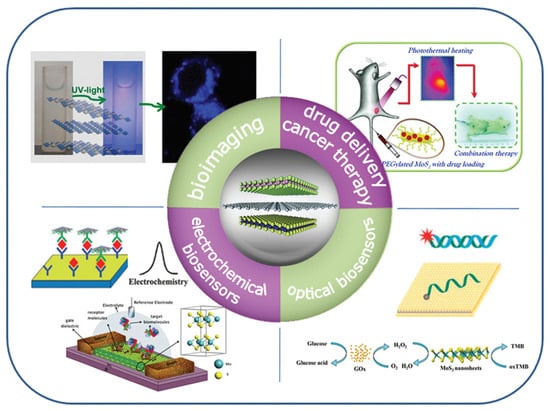
Figure 2.
Possible applications of 2D-based nanomaterials [16].
Graphene is one of the leading and primary 2D materials, and categorized as having sp2 hybridization, and is single-layered with extensive surface area structure. The honeycomb shaped structure of the graphene provides an easy fabrication of bioelectronic devices. The interesting properties such as high surface area, excellent electrical conductivity, and mechanical strength make graphene a promising candidate for different type of applications such as hydrogen storage, sensor, solar cells, and biosensor [17,18]. Dating back to 1940, the early discussion and theoretical explanation already proved the existence of graphene. However, the interest in graphene was sparked in 2010 with the Nobel prize award in physics to Prof. A. Geim and Prof. K. Novoselov for their ground-breaking research on the “graphene: 2D materials” [19]. The research reported by two Nobel Prize winners in 2010, cracked the mystery wall of graphene by the simple scotch tape experiment in 2004 [20,21].
Recently, a number of synthetic approaches have been developed for the synthesis of graphene. All the developed methodologies can be divided into two main categories: top-down and bottom-up, in a similar fashion to what is done with other nanostructured materials [22]. Because of the various physicochemical properties, graphene-based materials promote a functional interface for the development of bioelectronics with control of interfacial electrochemical properties. Because graphene shows anisotropic behavior at different areas of the same surface, it is said to possess two idiosyncratic parts (plane) on the same surface i.e., basal and edge planes (Figure 3), with different electrochemical properties. Because of the structural defect, the electrochemical reactions at the basal plane are slower than at edge planes on graphene interface. Meanwhile, some studies also report the time-dependent chemical activity for the basal plane [23].

Figure 3.
Schematic representation of the basal plane (active part) and the edge plane (less active part) of graphitic interface [24].
Direct immobilization of graphene on macro electrode surfaces (glassy carbon and gold) generates a heterogeneous interface. This type of heterogeneous interface initiates obstacles in revealing prodigy properties of the respective graphene. In this scenario, the electrode materials play a crucial role and even dictate the electrochemical behavior of the interface [25,26].
Interaction of graphene surface with biomolecules in bioelectronics: Interaction of graphene surface with biomolecules such as DNA, protein, enzyme, and cells depends on colloidal force and chemical and physical interactions. The interaction between graphene surface and biomolecules also plays a crucial role in bio-catalytic processes. Investigations have proved that these interactions are generally controlled by the size, shape, and surface characteristic of graphene materials. There are three possible types from the perspective of using graphene as bioelectronics, these include (i) graphene in contact with the biological substrate, (ii) surface of graphene defined by physicochemical composition, and (iii) solid–liquid interfaces, where graphene interacts with the respective surroundings [27,28].
3. Graphene in Biosensing
Graphene is a 2D, zero-band gap semiconductor, an electroactive and transparent material with unique properties such as high enzyme operational stability, enzyme loading, good catalytic activity, larger surface area, fast electron transfer rate for enzyme immobilization and hence it is increasingly being used as immobilization carriers in bioelectronics (Figure 4).
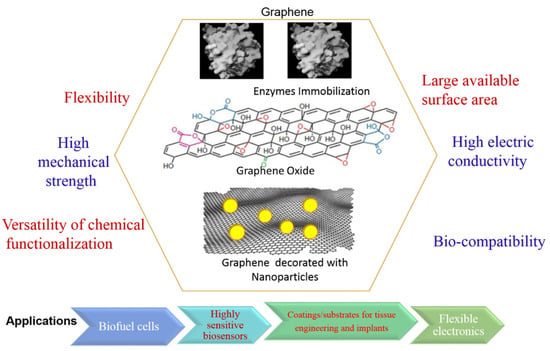
Figure 4.
Enzyme immobilization on graphene- diversity in applications.
Use of biosensors approach is paramount for improving the quality of human life. This approach is able to detect a wide range of compounds, and it has been employed to determine a variety of parameters of biological systems by translating a bio-recognition event into a measurable electronic or light signal. In the last century, several researchers have reported the interface between the biological and electronic world as bioelectronics [29,30,31]. Bioelectronics also assists researchers to study the basic relation between living systems and the artificial world. Because of breakthrough experiments in the field of biosensors and basic research, functional bio-device developments can build a platform whereby electronics can be integrated with biotechnology [32,33,34]. These types of advancement and developments in the field of biomaterials with various functionalities have increased the interests in bioelectronics [35]. Irrespective of the tremendous development in bioelectronics, there is a lack of regulation and control of biological systems at devices level.
The remarkable advantage of graphene over single-walled carbon nanotubes (SWCNTs) is its respective active surface area (2630 m2·g−1) [36]. Graphene-based materials have well-known characteristics of metallic impurities, which can be elude by using the CNT. Graphene has been used as a transducer in bio-field-effect transistors and different biosensors like electrochemical, impedance, and fluorescence. Recent reports of graphene-related materials have been focused on (bio) sensor development [17,37]. Functionalization of graphene by polymers enhances its application in different fields. Because of better biocompatibility and electro-catalytic behaviors, Shan et al. reported in 2009, a novel polyvinyl pyrrolidone-protected graphene/polyethylenimine-functionalized ionic liquid/glucose oxidase (GOD)-based electrochemical biosensor with an impressive response for 14 mM of glucose concentration. Shan et al. immobilized the enzyme onto pre-prepared graphene/AuNPs/chitosan nanocomposite matrix and the resultant electrode showed a great response against glucose with a linear range from 2 mM to 10 mM, at −0.2 V and showed great electro-catalytic activity toward H2O2 and O2 [38]. Another study confirmed that the immobilization of graphene-Pt nanoparticles (NP) improved the detection performance with a wider linear range and lower detection limit for H2O2 and trinitrotoluene (TNT) [39]. The modification of reduced graphene with biomolecules to detect glucose was also reported by Wang et al. [40]. The authors reported a nontoxic direct electrochemical method that was used to functionalize and reduce graphene oxide (rGO) (Figure 5) by using 3-aminopropyltriethoxysilane-modified conductive electrodes, and the modification of the reduced GO-glassy carbon electrode (GCE) with glucose oxidase (GOx).
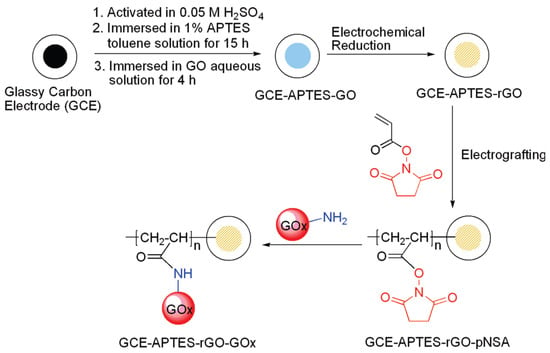
Figure 5.
A schematic diagram for electrochemical reduction of GO and the subsequent modification of rGO with GOx [40].
Huang et al. in 2011 studied the synthesis procedure of graphene-based biosensors. The graphene film was prepared by chemical vapor deposition, and then functionalized with anti-E. coli antibodies via the passivation technique (Figure 6). The nano-electronic sensor was generated based on an antibody-modified chemical-vapor deposition grown large-sized graphene to detect bacteria (E. coli) with great sensitivity (10 cfu/mL) [41].
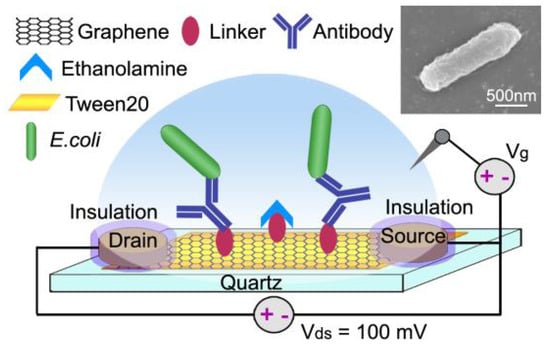
Figure 6.
Schematic diagram of anti-E. coli antibody functionalized graphene-field-effective transistor (FET), inset: SEM image [41].
4. Switchable Graphene Bioelectronics
Switchable biosensing system of bioelectronics is one of the recent and most promising applications. In the present era, switchable bioelectronics aims to develop new platforms for controlling and regulating the physiological mechanism in response to real life chemical and physical stimuli [42]. Switchable bioelectronics explores the natural biochemical interaction and mimics the biochemical reactions along with electron transfer phenomenon while controlling the environment under the influence of external stimuli (physical, chemical, electrical, and magnetic) [43]. A recent study in the field of switchable bioelectronics on graphene interface is at the stage of graphene-stimuli-responsive polymer hybrids capable of regulating and controlling the enzyme based bio-molecular reaction under the influence of temperature, pH, and light.
Recently in 2018, Wang et al. fabricated highly sensitive electrochemical phenol biosensor by using a graphene oxide-modified tyrosinase interface. This fabricated phenol biosensor was based on the covalent bonding of tyrosinase (TYR) onto a GO modified glassy carbon electrode (GCE) via glutarldehyde (GA) (Figure 7). The -OH group of GO played an important role for covalent bonding between graphene interface and TYR for the constructing electrochemical phenol biosensors [44].

Figure 7.
Schematic presentation of the development of TYR/GA/GO/GCE biosensor for the electrochemical determination of phenol derivatives; (a) GO casting on GCE, (b) covalent bonding of GO and GA, (c) covalent bonding of GA and TYR, and (d) electrochemical detection of phenol derivatives [44].
In the series of the development of graphene-based bioelectronics interface, in 2019, Sun et al. proposed a label-free and sandwiched-type immunosensor for the early diagnosis of primary liver cancer. In this study, an electrochemical immunosensor, based on label-free and sandwiched strategies was used where AuPt-vertical linked with graphene/GCE (AuPt-VG/GCE) for alpha-fetoprotein (AFP) detection. Because of noble biocompatibility and excellent conductivity, AuPt nanoparticles were used to immobilize the primary antibody (Ab1), while vertical graphene sheet helped to accelerate the electron transfer at the liquid–solid and solid–solid interface (Figure 8). The outcome of this investigation highlights that the sensing electrode played a crucial role in signal amplification and sensitivity of the sandwiched-type sensor, which is higher than that of label-free sensor. The fabricated immunosensor (AuPt-VG/GCE) has excellent performance for the detection of AFP in human serum along with the promising stability, recommending its potential application in clinical monitoring of AFP and other tumor marker [45].
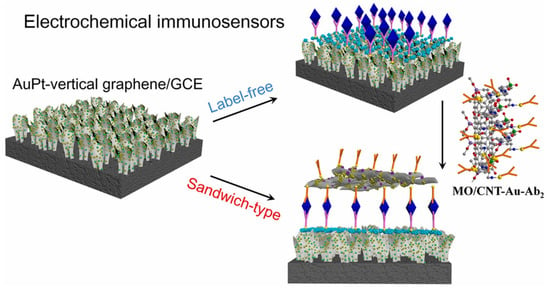
Figure 8.
Schematic illustration of the development label-free and sandwiched-type approach for AuPt-VG/GCE-based bioelectronic interfaces for the detection of liver cancer marker i.e., alpha-fetoprotein [45].
The electrochemical measurements have shown that the sensing properties can be tuned by varying the external stimuli such as pH, temperature, ionic strength, and magnetic field. The fundamental design leads to a self-switching bio-catalysis by utilizing simple to use, cost-effective, and stable biodevices. In this respect, in 2014 Song et al. fabricated a PH-responsive electrochemical sensing platform based on the chitosan-reduced graphene oxide/concanavalin A (CS-rGO/ConA) for bi-analytical detection of glucose and urea. The strategy for the glucose and urea sensing involved the in situ pH-switchable enzyme catalyzed sensing behavior. The net charge of pH-dependent behavior of CS-rGO/ConA interface exhibited the pH-switchable responses against the negatively charged Fe(CN)63−. In this graphene-based dual bioreactor, oxidation of glucose catalyzed by glucose oxidase or the hydrolyzation of urea catalyzed by urease enzyme resulted in pH changes of the electrolyte solution to give a set of electrochemical response (Figure 9). This investigation reveals that sensing performance of graphene-based bioelectronic systems have potential for simultaneous assay of dual analytes (glucose and urea) [46]. This work has proven that two analytes can be detect in one sample and they can be discriminated based on their pH responsive environment of analytes solutions. In addition, this report also provides a strategy for the detection of non-electroactive species based on the enzyme catalyzed reaction. The summary of pioneered graphene-based switchable bioelectronic is presented in Table 1. The table shows some of the pioneered works on the fabrication of graphene-based devices that have been reported during the past decades.
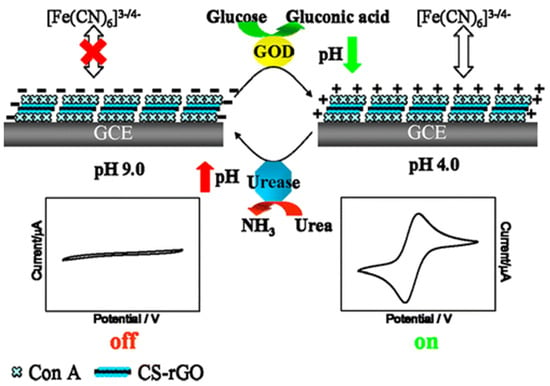
Figure 9.
Schematic illustration of pH-switchable behavior of Fe(CN)63− on the ConA/CS-rGO/GCE triggered by the enzyme-catalyzed reactions [46].

Table 1.
Graphene-based switchable bioelectronics.
5. Conclusions and Future Perspective
In conclusion, a wide range of graphene with different morphology, composition, size, and shape have been explored for the electrical communication between electronic and biological counterparts. These electrical communications explains the understanding of the electron transfer and charge transfer pathways in biological systems. It is very difficult to predict the impact of this emergent technology. Although potential applications of this technology heightens the interest for further research works for practical and fundamental solutions real problems. This review article focused on switchable bioelectronics technology based on stimuli-responsive interface. However, this area is still at the zygotic level and needs more exploration. Meanwhile, the first report on graphene opened consequence advancement in the area of bioelectronics with large-scale, low-cost, high-quality methods for the identification, detection, and quantification of biomolecules. Nevertheless, the present approach for fabricating bioelectronic devices is not well established for practical application and commercialization. In conclusion, the device and materials biocompatibility along with new technological approaches for wearable and implantable bioelectronic devices needs further investigation.
Author Contributions
M., S.K.S., J.N. and V.K. planned to designed and prepare the draft; P.P.G., A.N., C.M.H., R.W., B.M. and R.S.B. put their contribution to scientific and English proof editing. All authors have read and agreed to the published version of the manuscript.
Funding
This research received no external funding.
Conflicts of Interest
There is no conflict of interest.
References
- Prianka, T.R.; Subhan, N.; Reza, H.M.; Hosain, K.; Rahman, A.; Lee, H.; Sharker, S.M. Recent exploration of bio-mimetic nanomaterials for potential biomedical applications. Mater. Sci. Eng. C 2018, 93, 1104–1115. [Google Scholar] [CrossRef]
- National Institute of Standards and Technology. A Framework for Bioelectronics: Discovery and Innovation; National Institute of Standards and Technology, Department of Commerce: Gaithersburg, MD, USA, 2018. Available online: https://www.nist.gov/engineering-physics-division/framework-bioelectronics-discovery-and-innovation (accessed on 25 August 2019).
- Simon, D.T.; Larsson, K.C.; Nilsson, D.; Burström, G.; Galter, D.; Berggren, M.; Richter-Dahlfors, A. An organic electronic biomimetic neuron enables auto-regulated neuromodulation. Biosens. Bioelectron. 2015, 71, 359–364. [Google Scholar] [CrossRef] [PubMed]
- Huang, X.; Zeng, Z.Y.; Fan, Z.X.; Liu, J.Q.; Zhang, H. Graphene-based electrode. Adv. Mater. 2012, 24, 5979–6004. [Google Scholar] [CrossRef] [PubMed]
- Wang, Y.; Li, Z.; Wang, J.; Li, J.; Linb, Y. Graphene and graphene oxide: Biofunctionalization and applications in biotechnology. Trends Biotechnol. 2011, 29, 205–212. [Google Scholar] [CrossRef] [PubMed]
- Löffler, S.; Libberton, B.; Richter-Dahlfors, A. Organic bioelectronic tools for biomedical applications. Electronics 2015, 4, 879–908. [Google Scholar] [CrossRef]
- Duan, X.; Lieber, C.M. Nanoscience and the nano-bioelectronics frontier. Nano Res. 2015, 8, 1–22. [Google Scholar] [CrossRef]
- Noy, A. Bionanoelectronics. Adv. Mater. 2011, 23, 807–820. [Google Scholar] [CrossRef]
- Rivnay, J.; Owens, R.M.; Malliaras, G.G. The rise of organic bioelectronics. Chem. Mater. 2013, 26, 679–685. [Google Scholar] [CrossRef]
- Someya, T.; Bao, Z.; Malliaras, G.G. The rise of plastic bioelectronics. Nature 2016, 540, 379–385. [Google Scholar] [CrossRef]
- Lee, G.H.; Yu, Y.J.; Cui, X.; Petrone, N.; Lee, C.H.; Choi, M.S.; Lee, D.Y.; Lee, C.; Yoo, W.J.; Watanable, K.; et al. Flexible and tranparent MoS2 field-effect transistors on hexagonal boron nitride-graphene heterostrures. ACS Nano 2013, 7, 7931–7936. [Google Scholar] [CrossRef]
- Geim, A.K. Graphene: Status and Prospects. Science 2009, 324, 1530–1534. [Google Scholar] [CrossRef] [PubMed]
- Geim, A.K.; Grigorieva, I.V. Van der Waals heterostructures. Nature 2013, 499, 419–425. [Google Scholar] [CrossRef] [PubMed]
- Bunch, J.S.; Zande, A.M.; Verbridge, S.S.; Frank, I.W.; Tanenbaum, D.M.; Parpia, J.M.; Craighead, H.G.; McEuen, P.L. Electrochemical resonators from graphene sheets. Science 2007, 315, 490–493. [Google Scholar] [CrossRef] [PubMed]
- Zhang, N.M.Y.; Li, K.; Shum, P.P.; Yu, X.; Zeng, S.; Wu, Z.; Wang, Q.J.; Yong, K.-T.; Wei, L. Hybrid graphene/gold plasmonic fiber-optic biosensor. Adv. Mater. Technol. 2016, 2, 1600185. [Google Scholar] [CrossRef]
- Yang, G.; Zhu, C.; Du, D.; Zhu, J.; Lin, Y. Graphene-like two-dimensional layered nanomaterials: Applications in biosensors and nanomedicine. Nanoscale 2015, 7, 14217–14231. [Google Scholar] [CrossRef]
- Shao, Y.; Wang, J.; Wu, H.; Liu, J.; Aksay, I.A.; Lin, Y. Graphene based electrochemical sensor and biosensor: A review. Electroanalysis 2010, 22, 1027–1036. [Google Scholar] [CrossRef]
- Janegitz, B.C.; Dos Santos, F.A.; Faria, R.C.; Zucolotto, V. Electrochemical determination of estradiol using a thin film containing reduced graphene oxide and dihexadecylphosphate. Mater. Sci. Eng. C 2014, 37, 14–19. [Google Scholar] [CrossRef]
- Novoselov, K.S.; Geim, A.K.; Morozov, S.V.; Jiang, D.; Zhang, Y.; Dubonos, S.V.; Grigorieva, I.V.; Firsova, A.A. Electrocal field effect in atomically thin carbon films. Science 2004, 306, 666–669. [Google Scholar] [CrossRef]
- Neto, A.H.C.; Guinea, F.; Peres, N.M.R.; Novoselov, K.S.; Geim, A.K. The electronic properties of grapheme. Rev. Mod. Phys. 2009, 81, 109–162. [Google Scholar] [CrossRef]
- Geim, A.K.; Novoselov, K.S. The rise of grapheme. Nat. Mater. 2007, 6, 183–191. [Google Scholar] [CrossRef]
- Ambrosi, A.; Chua, C.K.; Bonanni, A.; Pumera, M. Electrochemistry of graphene and related materials. Chem. Rev. 2014, 115, 7150–7188. [Google Scholar] [CrossRef] [PubMed]
- Brownson, D.A.C.; Banks, C.E. Graphene electrochemistry: An overview of potential applications. Analyst 2010, 135, 2768–2778. [Google Scholar] [CrossRef] [PubMed]
- Zhang, G.; Kirkman, P.M.; Patel, A.N.; Cuharuc, A.S.; Mckelvey, K.; Unwin, P.R. Molecular functionalization of graphene surfaces: Basal plane versus step edge electrochemical activity. J. Am. Chem. Soc. 2014, 136, 11444–11451. [Google Scholar] [CrossRef] [PubMed]
- Zhou, M.; Zhai, Y.; Dong, S. Electrochemical sensing and biosensing platform based on chemically reduced graphene oxide. Anal. Chem. 2009, 81, 5603–5613. [Google Scholar] [CrossRef] [PubMed]
- Hossain, M.F.; Park, J.Y. Fabrication of sensitive enzymatic biosensor based on multi-layered reduced graphene oxide added PtAu nanoparticles-modified hybrid electrode. PLoS ONE 2017, 12, e0173553. [Google Scholar] [CrossRef]
- Konkena, B.; Vasudevan, S. Understnding aqueous dispersibility of graphene oxide and reduced graphene oxide through pKa measurements. J. Phys. Chem. Lett. 2012, 3, 867–872. [Google Scholar] [CrossRef]
- Morales-Narváez, E.; Merkoçi, A. Graphene oxide as an optical biosensing platform. Adv. Mater. 2012, 24, 3298–3308. [Google Scholar] [CrossRef]
- Clark, L.C., Jr.; Lyons, C.; Ann, N.Y. Electrode systems for continuous monitoring in cardiovascular system. Acad. Sci. 1962, 102, 29–45. [Google Scholar] [CrossRef]
- Turner, A.P.F.; Karube, I.; Wilson, G.S. Biosensors: Fundamentals and Applications; Oxford University Press: Oxford, UK, 1987. [Google Scholar]
- Willner, I.; Katz, E. Bioelectronics: From Theory to Applications; John Wiley & Sons: New York, NY, USA, 2006. [Google Scholar]
- Berggren, M.; Richter-Dahlfors, A. Organic bioelectronics. Adv. Mater. 2007, 19, 3201–3213. [Google Scholar] [CrossRef]
- Cave, J.W.; Wickiser, J.K.; Mitropoulos, A.N. Progress in the development of olfactory-based bioeelctronics chemosensors. Biosens. Bioelectron. 2019, 123, 211–222. [Google Scholar] [CrossRef]
- Willner, I.; Willner, B. Biomaterials integrated with electronic elements: En route to bioelectronics. Trends Biotechnol. 2001, 19, 222–230. [Google Scholar] [CrossRef]
- Joachim, C.; Gimzewski, J.K.; Aviram, A. Electronics using hybrid-molecular and mono-molecular devices. Nature 2000, 408, 541–548. [Google Scholar] [CrossRef] [PubMed]
- Dreyer, D.R.; Park, S.; Bielawski, C.W.; Ruoff, R.S. The chemistry of graphene oxide. Chem. Soc. Rev. 2010, 39, 228. [Google Scholar] [CrossRef] [PubMed]
- Li, L.; Wu, G.; Yang, G.; Peng, J.; Zhao, J.; Zhu, J. Focusing on luminescent graphene quantum dots: Current status and future perspectives. Nanoscale 2013, 5, 4015–4039. [Google Scholar] [CrossRef]
- Shan, C.; Yang, H.; Song, J.; Han, D.; Ivaska, A.; Niu, L. Direct electrochemistry of glucose oxidase and biosensing for glucose based on graphene. Anal. Chem. 2009, 81, 2378–2382. [Google Scholar] [CrossRef]
- Guo, S.; Wen, D.; Zhai, Y.; Dong, S.; Wang, E. Platinum nanoparticle ensemble-on-graphene hybrid nanosheet: One-pot, rapid synthesis, and used as new electrode material for electrochemical sensing. ACS Nano 2010, 4, 3959–3968. [Google Scholar] [CrossRef]
- Wang, Z.; Zhou, X.; Zhang, J.; Boey, F.; Zhang, H. Direct electrochemical reduction of single-layer graphene oxide and subsequent functionalization with glucose oxidase. J. Phys. Chem. C 2009, 113, 14071–14075. [Google Scholar] [CrossRef]
- Huang, Y.; Dong, X.; Liu, Y.; Li, L.-J.; Chen, P. Graphene-based biosensors for detection of bacteria and their metabolic activities. J. Mater. Chem. 2011, 21, 12358–12362. [Google Scholar] [CrossRef]
- Bocharova, V.; Katz, E. Switchable electrode interfaces controlled by physical, chemical and biological signals. Chem. Rec. 2011, 12, 114–130. [Google Scholar] [CrossRef]
- Privman, M.; Tam, T.K.; Pita, M.; Katz, E. Switchable electrode controlled by enzyme logic network system: Approaching physiologically regulated bioelectronics. J. Am. Chem. Soc. 2009, 131, 1314–1321. [Google Scholar] [CrossRef]
- Wang, Y.; Zhai, F.; Hasebe, Y.; Jia, H.; Zhang, Z. A highly sensitive electrochemical biosensor for phenol derivatives using a graphene oxide-modified tyrosinase electrode. Bioelectrochemistry 2018, 122, 174–182. [Google Scholar] [CrossRef] [PubMed]
- Sun, D.; Li, H.; Li, M.; Li, C.; Qian, L.; Yang, B. Electrochemical immunosensors with AuPt-vertical graphene/glassy carbon electrode for alpha-fetoprotein detection based on label-free nd sandwich-type strategies. Biosens. Bioelectron. 2019, 132, 68–75. [Google Scholar] [CrossRef] [PubMed]
- Song, Y.; Liu, H.; Tan, H.; Xu, F.; Jia, J.; Zhang, L.; Li, Z.; Wang, L. pH-switchable electrochemical sensing platform based on chitosan-reduced graphene oxide/concanavalin a layer for assay of glucose and urea. Anal. Chem. 2014, 86, 1980–1987. [Google Scholar] [CrossRef]
- Parlak, O.; Turner, A.P.F.; Tiwari, A. pH-induced on/off-switchable graphene bioelectronics. J. Mater. Chem. B 2015, 3, 7434–7439. [Google Scholar] [CrossRef] [PubMed]
- Akkaya, B.; Çakıroğlu, B.; Özacar, M. Tannic Acid-Reduced Graphene Oxide Deposited with Pt Nanoparticles for Switchable Bioelectronics and Biosensors Based on Direct Electrochemistry. ACS Sustain. Chem. Eng. 2018, 6, 3805–3814. [Google Scholar] [CrossRef]
- Parlak, O.; Turner, A.P.F.; Tiwari, A. On/off-switchable zipper-like bioelectronics on a graphene interface. Adv. Mater. 2013, 26, 482–486. [Google Scholar] [CrossRef]
- Parlak, O.; Beyazit, S.; Jafari, M.J.; Bui, B.T.S.; Haupt, K.; Tiwari, A.; Turner, A.P.F. Light-triggered switchable graphene-polymer hybrid bioelectronics. Adv. Mater. Interfaces 2016, 3, 1500353. [Google Scholar] [CrossRef]
- Mishra, S.; Ashaduzzaman, M.; Mishra, P.; Swart, H.C.; Turner, A.P.; Tiwari, A. Stimuli-enabled zipper-like graphene interface for auto-switchable bioelectronics. Biosens. Bioelectron. 2017, 89, 305–311. [Google Scholar] [CrossRef]
- Yuan, F.; Zhao, H.; Zang, H.; Ye, F.; Quan, X. Three-Dimensional Graphene Supported Bimetallic Nanocomposites with DNA Regulated-Flexibly Switchable Peroxidase-Like Activity. ACS Appl. Mater. Interfaces 2016, 8, 9855–9864. [Google Scholar] [CrossRef] [PubMed]
© 2020 by the authors. Licensee MDPI, Basel, Switzerland. This article is an open access article distributed under the terms and conditions of the Creative Commons Attribution (CC BY) license (http://creativecommons.org/licenses/by/4.0/).